|
|
Guide to Frost
... Different types of ice structures that form on the ground ... |
|
| Frost crystals grow from water vapor
in the air, just like snow crystals (see the
Snowflake Primer). But while snow crystals form on suspended
dust particles high in the clouds, frost crystals form near the ground
-- on window
panes, blades of grass, or just about any other solid surface. |
| Window
Frost |
 Window frost forms when a pane of glass is exposed to below-freezing temperatures on the
outside and moist air on the inside. Water vapor from the air condenses
as frost on the inside surface of the window. The picture at right shows a patch
of window frost about the size of an outstretched hand. Window
frost often makes elaborate patterns as the crystal
growth is strongly influenced by the window surface. Scratches,
residual soap streaks, etc., can all change the way the crystals
nucleate and grow.
Window frost forms when a pane of glass is exposed to below-freezing temperatures on the
outside and moist air on the inside. Water vapor from the air condenses
as frost on the inside surface of the window. The picture at right shows a patch
of window frost about the size of an outstretched hand. Window
frost often makes elaborate patterns as the crystal
growth is strongly influenced by the window surface. Scratches,
residual soap streaks, etc., can all change the way the crystals
nucleate and grow.
Window frost was more common in the past, when houses
still had single-pane windows. The newer double-pane windows are
much better insulators and thus not so cold on the inside surfaces.
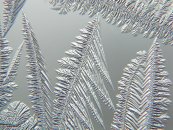 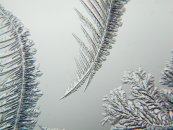
At
left are some close-up pictures of window frost I took during a recent vacation in the California mountains.
The branches you see here are tiny -- each about 3mm in length.
The magnified view shows some of the same faceting and dendritic
structures that you see in snowflakes. |
| Hoarfrost |
Frost
is to dew as snowflakes are to raindrops. When water vapor
condenses into liquid water, you get raindrops and dew. When water
vapor condenses directly into ice, then you get snowflakes and frost (see the Snowflake Primer).
Snowflakes are not frozen raindrops, and likewise frost is not frozen dew.
When frost forms as minute ice crystals covering the ground, we just call it
all frost. But sometimes the frost grains grow larger and are called hoarfrost
crystals. Good hoarfrost is not that uncommon if you watch for it.
Hoarfrost grows whenever it's cold outside and there is a ample source of water vapor
nearby.
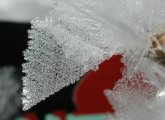  We ran across some great hoarfrost crystals while cross-country
skiing early one morning in the California mountains,
which you can see in these pictures. A nearby unfrozen stream was the source of
water vapor, which condensed into these crystals overnight. We ran across some great hoarfrost crystals while cross-country
skiing early one morning in the California mountains,
which you can see in these pictures. A nearby unfrozen stream was the source of
water vapor, which condensed into these crystals overnight.
Some of the crystals grew pretty large (that's a ski for scale) and had the
same lacy structure as dendritic snow crystals (see the Snowflake Primer).
By midmorning they had all disappeared.
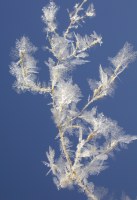
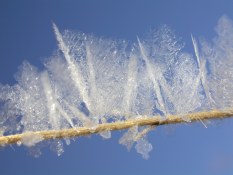 The pictures at left are of more hoarfrost crystals I found in northern
Ontario near James Bay. The first picture shows a twig of grass
that is covered with ice crystal "leaves". The second picture
shows a closer view of a small stalk with some very long dendritic
crystals.
The pictures at left are of more hoarfrost crystals I found in northern
Ontario near James Bay. The first picture shows a twig of grass
that is covered with ice crystal "leaves". The second picture
shows a closer view of a small stalk with some very long dendritic
crystals.
One of the best places to find hoarfrost is on exposed plants near
unfrozen lakes and streams. It's a nice thing to look for if
you're out hiking in the woods on a winter morning. |
| I found lots more hoarfrost crystals
to photograph in
northern Japan. |
Grow Your
Own Frost.
You can make your own hoarfrost crystals if you have a cold, wind-free location --
for example, an unheated outdoor shed. Just plug in a hotplate and heat an open pan
of water over a low heat for a day or two. You'll want to heat the water without
heating the whole shed, so it helps if it's good and cold outside.
You may want to provide a branch or some other artistic surface above the pan
for water vapor to condense onto. How the crystals grow will depend on the air
temperature (see the Snowflake Primer),
so you may find different types of hoarfrost crystals on different days. If you see
something interesting when you try this, take some pictures (see Photographing
Snow for useful techniques) and send me an e-mail. |
| Surface
Hoar |
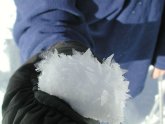 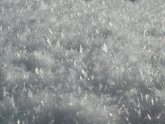 The most common form of
hoarfrost is called surface hoar. This consists of ice crystals that form
on top of snow banks, usually overnight. The sparkles you see coming from a field of
snow are often reflections off the facets of surface hoar crystals. The most common form of
hoarfrost is called surface hoar. This consists of ice crystals that form
on top of snow banks, usually overnight. The sparkles you see coming from a field of
snow are often reflections off the facets of surface hoar crystals.
Surface hoar typically forms when a snowbank warms up during the day and is then cooled
again overnight. The night air cools the surface of the snowbank more than the
inside, so that water can evaporate from inside the snowbank and recrystalize on the
surface. By morning the snowbank is covered with a layer of faceted ice crystals,
and they can be quite large. These usually melt again once the sun comes up, so the
best time to find surface hoar is early in the morning.
|
|
Frost Flowers |
 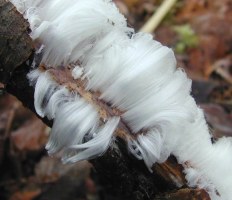 Some of the stranger ice formations you're likely to find in the woods
are
called "frost flowers" or "feather frost". A typical example
looks like a small puff-ball of cotton candy, a few inches across, made
up of clusters of thin, curved ice filaments.
Some of the stranger ice formations you're likely to find in the woods
are
called "frost flowers" or "feather frost". A typical example
looks like a small puff-ball of cotton candy, a few inches across, made
up of clusters of thin, curved ice filaments.
Frost flowers usually grows on
a piece of water-logged wood, as shown in the pictures at right (taken
by Nick Page; provided
by Alan Rempel). It's something of a rare find, meaning that
conditions have to be just so before it will form.
Not much has been written on this unusual phenomenon, and to my
knowledge it has never been reproduced in a controlled laboratory
environment. It appears that the ice filaments are essentially
pushed out from pores in the wood as they freeze.
It's something of a misnomer to call this frost, by the way, since
it freezes from liquid water, not water vapor. |
|
Rime Formations |
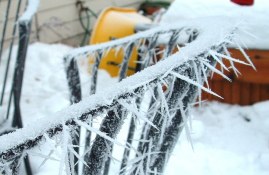 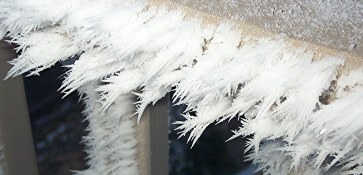 |
|
Snow crystals accumulate rime when they collide with water droplets in
the clouds (see the
Guide to Snowflakes (near the bottom of that page)). When the
clouds are near the ground you have fog, and sometimes the fog is made
from supercooled water droplets -- water at a temperature below the
freezing point. Then the droplets freeze on contact to anything
they hit, sometimes yielding some bizarre, wind-driven rime formations.
The pictures of this phenomenon above were sent by Keenan and David
Mackey (first picture) and by John Gibson (second). |
|
|
